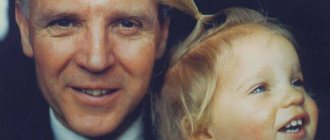In the 20th century, personality theories in psychology developed simultaneously in several directions. And today, the basic concepts and approaches, despite rather contradictory conclusions, allow us to get the most complete picture of a person’s personality.
They provide an opportunity to examine his psyche from different angles. The relativity of these theories can be represented as different projections of one complex and multifaceted subject.
Foreign psychology
In foreign psychology, several approaches can be distinguished within the framework of which the phenomenon of personality is interpreted.
Biologization approach
It is based on the idea of the biological processes of maturation of the organism, divided into universal stages.
S. Hall's theory
In his concept, the author was guided by the law of recapitulation, that is, he argued that in his development, each person goes through the stages of development of the entire society.
Theory of E. Kretschmer
The author claims that there is a connection between a person’s constitution and his personal development.
S. Freud's theory
According to this concept, all human behavior and development is permeated with unconscious drives and instincts, especially sexual ones.
Sociogenetic approach
Representatives of this direction focus on the relationship between personal development and socialization, the development of society, and the relationship of the individual with the environment. That is, a person becomes a person only in society, in the process of social relations.
Theory of E. Thorndike and B. Skinner
The life of an individual is the result of reinforced learning, assimilation of knowledge and skills.
K. Levin's theory
The author developed a “field theory”, or “living space”. According to the concept, personality is controlled by aspirations and intentions. They, in turn, are expressed in the direction, size and point of contact with the personality field.
Psychogenetic approach
Representatives of this direction do not exclude the influence of both factors (biological and environmental). But the development of mental processes comes first in importance.
E. Erikson's theory
A psychodynamic concept according to which the leading elements of personality are non-rational, for example, emotions and aspirations.
Theories of J. Piazget, J. Kelly
Cognitive concepts that focus on the cognitive development of the individual.
Theories of E. Spranger, K. Bueller, A. Maslow, K. Rogers
Personological concepts, the authors of which considered the development of personality as a whole, and not by categories.
Theories of personality specificity
Some authors devoted their research to identifying characteristic personality traits, behavioral factors, and characteristics.
R. Cattell's theory
The author identified 16 factors (stable traits) that can be used to predict a person’s behavior (figure below).
Basic personality traits according to R. Cattell
G. Eysenck's theory
An English psychologist considered 2 distinctive areas of personality:
- extraversion (introversion);
- neuroticism (stability or instability of the emotional sphere).
The combination of these elements creates a personality type. As a result, 4 personality types can be distinguished (picture below).
Eysenck's personality types
Even against the background of the analysis of these concepts, one can note the blurring of the boundaries between the concepts of personality, individual, individuality, character, temperament, innate and acquired.
Conclusion:
There are many more views on the processes of human development. Other theories of personality development are behaviorism, the existential direction, humanistic theories, and the already mentioned psychoanalysis. Each of these concepts occupies a special place in psychological knowledge.
When thinking about our own development, we do not demand precision and mathematical rigor from psychological theories. After all, life is like the bed of a river, and personality cannot be described using a single formula, just as it is impossible to give an exact definition to each wave in this river.
Topics: Psychology of women, Psychology of men, Personal growth
Domestic psychology
Russian psychology is permeated with the idea of the relationship between man and the world.
Theory of N. A. Berdyaev
According to the concept, the individual cannot be identified with society. Society is part of the individual. The personality itself is an ethical and spiritual category. Each personality contains something common to all people and something different.
There is a degree of mysticism in the perception of personality as something spiritual, but this theory served as the basis for many current provisions about the phenomenon of man as a personality.
The theory of relations by V. N. Myasishchev
According to the concept, a person as an individual is characterized through a system of conscious relationships. The author highlights a person’s attitude to the world of nature and things, people and society, to himself as an individual. At the same time, the system of relations is subordinated to a certain hierarchy, which reflects the significance of the objects of relations for a person.
At the same time, any human relationship is endowed with the following characteristics:
- arises, develops, takes shape and disintegrates in the process of human life;
- always expresses the personality as a whole;
- meaningful (has a subject);
- at a certain level consciously;
- is of a direct or indirect nature (related to a process or place);
- related to needs;
- has three aspects (volitional, cognitive, emotional);
- selectively;
- generalized to varying degrees;
- differs in significance and sustainability.
The author brought relationships with people to the fore.
The development of any relationship, that is, the personality itself, is influenced by upbringing and self-education based on innate characteristics, as well as the social conditions of development and the conscious activity of a person.
Theory of V. S. Merlin
Merlin continued Myasishchev’s theory, but differentiated the concepts of “attitude” and “personal attitude,” or mental properties. In the author’s concept it sounds like this: “Personal properties are only those properties in which personality relationships are expressed.”
The author was one of the first domestic researchers to consider personality as a unity of properties, and not a collection of individual elements. As a result, the psychologist noted the generality, activity and stability of the relationship. These are characteristics that are responsible for exactly how and how quickly the symptom complex (certain interrelated personality properties) changes depending on changes in external conditions.
The author determined that the integrity of the individual depends on the equal development and influence of 3 factors (motives):
- ideological orientation;
- desire for self-expression;
- satisfaction of material needs and organic drives.
This approach is useful in studying the nature of neuroses, character disorders, personality and mental disorders.
Critical moments in the formation of personality according to Erikson
The transition from one stage to another is accompanied by a personal crisis. After all, new paths of development open up before a person. The outcome of the crisis is influenced by the choice of the person himself.
One of the most important stages in Erikson's theory is adolescence, which includes adolescence. In addition to the differences in Freud's views on this age (the emergence of psychosexual conflict), the scientist points out other problems inherent to this age. Teenagers develop their own views on the world.
They idealize what a family or religion should be like. These ideals are very far from imperfect, but really existing families, religions, and social institutions. The teenager is sure that realizing an ideal is no more difficult than dreaming about it.
Erikson believes that the main conflict of early adulthood is the possibility of building close relationships. But the scientist understands by them not only and not so much physical intimacy, although in marriage these factors are connected. By intimacy, the scientist understands the following: a person must learn frankness without fear of losing himself.
At the stage of middle maturity, the individual fluctuates between self-absorption and interest in other people and the destinies of generations. For most adults, children have already become teenagers by this time (at least, this is what Erikson believed at the time). People can devote themselves to their chosen work with complete dedication.
At the last stage, personality development factors from the previous stages play an important role. If a person feels satisfied with the life he has lived, looking back at the years he has lived, he will feel wholeness and peace. If the path traveled seems like a series of mistakes and lost opportunities, he will tragically realize that the lost life cannot be returned.
Afterword
The concepts discussed are similar in some ways, but completely different in others. In particular, there is no clear answer about what ultimately comes first: man or society, nature or the environment.
But if we focus on domestic concepts, we can note that a person becomes a person under the influence of society, through relationships and the assimilation of cultural experience.
You can read more about what personality is in the articles “The concept of personality in psychology: essence and structure” and “Personality orientation - what is it in psychology.”
Birth order in the family: life styles according to Adler
Adler was the first to notice that in the same family children can have completely different characters. The firstborn is a child who can only be envied. After all, parents usually give all their love to their first child. But this happens for the time being - until another child appears in the family.
When the second is born, the firstborn becomes “a monarch who was unjustly dethroned.” He begins to fight for the lost love of his parents. But all his efforts are doomed to failure. And over time, he realizes the futility of his attempts. His parents are always too busy and indifferent for him. In addition, they are now endowed with much more power than they once were: after all, they can appeal to the inappropriate immaturity of the older child. Their response to the firstborn's demand for love is punishment.
As a result, those who were born first in the family develop a special lifestyle. They accustom themselves to isolation, not needing affection or anyone's approval. In addition, Adler notes, the eldest is always inclined to lead.
What is the situation with the second child? For him, his older brother or sister is always his role model. The current situation pushes him or her to compete with him or her, trying to beat his records. If there are other children in the family, then the second child also fights with them for parental love. And this only increases his ambitions. The lifestyle of an adult who has grown from a second child is a continuous desire to prove his superiority. Unconsciously, he strives to show: I am better than my older brother or sister.
The last child occupies a special position. He is the one who will never experience the feeling of being “dethroned.” But if the family is poor, then he will constantly have to use the things and toys of his elders. The younger child will also develop feelings of inferiority. But he has one advantage: his motivation to surpass his elders is the highest.
Adler considers the position of the only child in the family unique. Since he has no one to compete with, such children’s rivalry with their father becomes especially strong. The lifestyle of an only child who has become an adult is egocentrism mixed with dependence.
Classification of theories
Personality types in psychology - varieties
Psychologists formulate personality theories based on the issues described above. Today there is a fairly stable classification of theories that reveals different aspects of personality and its behavior in society.
Psychologists deal with personal problems
Man as an individual
A brief description of the concept of individuality states that it is a unique personal form of a person, which has unique characteristics that distinguish him from other representatives of society. These include personality elements such as a person's temperament, interests, intelligence, needs and skills. In addition to individuality, these personality qualities determine a person’s place and role in social society, as well as his desire for social mobility.
Theories that study classes of people
Sociology is the study of classes of people. A separate branch of it is noted - social stratification, which divides people into “layers”, uniting social statuses according to certain separate criteria. People have been divided into classes for a very long time, it all started with classes based on a person’s origin, family status, etc. After the industrial period, the concept of social mobility arose, i.e. the ability to “move” between classes, from now on it began to depend only on individual.
Basic Concepts
Hyperthymic personality type - what is it in psychology?
Personality is a social individual, a set of relationships, activities and behavior that characterize a person.
Note! Personality theories in psychology are a set of hypotheses and definitions with the help of which the mechanisms of personal development are studied. Their main task is to explain human behavior, as well as learn to predetermine it.
Structural elements of personality theory in psychology
S. Freud is considered the author of the structural theory and structural principle of personality development. He conditionally divided the personality model into 3 components:
- Id (It). A congenital element that occurs when a child is born. At the same time, the baby strives to get something that will make him feel good here and now, no matter what. For example, loud crying until the need (to eat, to communicate) is met;
- Ego (I). Formed during the first 3 years of life. The child realizes that his behavior has a response. For example, before doing something forbidden, the Ego begins to remind you of possible negative consequences;
- Superego (Super Ego). It is in shape by the age of 5 years. This personal element is based on the principles and ideals received from parents and environment. It is considered equivalent to conscience due to the ability to evaluate “good” and “bad.”






